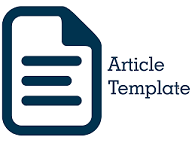Undergraduate Students' Needs Toward Instructional Material During Pandemic
Abstract
This study aims to get an overview of student needs for teaching materials during the covid-19 pandemic. The subjects in this study were 47 students of the out-of-school education study program class of 2020/2021. This type of research is descriptive with a qualitative approach. The data in this study were obtained from the results of a questionnaire distributed using a google form that has been provided by the researcher to find out the responses of students of out-of-school education study programs to the need for teaching materials during online lectures during the pandemic. The results obtained from the analysis of student needs for teaching materials during the pandemic are: first, during the pandemic in online lectures, as many as 91.5% of students are more interested in finding references or lecture materials digitally. Second, as many as 66.7% of students stated that the reason for choosing digital teaching materials was that they were practical to use. Third, 100% of students need interesting digital teaching materials. Fourth, as much as 76.6% can increase student motivation in learning. Fifth, for the form of teaching materials needed by students, as many as 82.6% of students need Android-based interactive textbooks because they are easy to access anywhere and easy to understand. This shows that students need teaching materials that support the lecture process during the pandemic, where lectures are conducted online.
Full Text:
PDFReferences
Ardiansyah, R., Corebima, A. D., & Rohman, F. (2016). Analisis Kebutuhan Pengembangan Bahan Ajar Perubahan Materi Genetik pada Matakuliah Genetika di Universitas Negeri Malang. Seminar Nasional Pendidikan Dan Saintek 2016, 2016, 1.
Cahyanto, B., & Afifulloh, M. (2021). Analisis Kebutuhan Pengembangan Bahan Ajar Elektronik di Era Pandemi Covid-19. Jurnal Pendidikan Dasar Indonesia 6 (2), 1-6.
Cahyanto, B., Akbar, S., & Sa, C. (2018). Desain Fisik Kelas Berbasis Tema untuk Sekolah Dasar. Pendidikan, 3(2002), 15– 20.
Czajka, C. D., & McConnell, D. (2019). The adoption of student-centered teaching materials as a professional development experience for college faculty. International Journal of Science Education, 41(5), 693–711. https://doi.org/10.1080/09500693.2019.1578908
Harto, K. (2018). Tantangan Dosen Ptki Di Era Industri 4.0. Jurnal Tatsqif, 16(1), 1–15. https://doi.org/10.20414/jtq.v16i1.159
Hobbs, D. J. (1987). Effects of Content Sequencing and Presentation Mode of Teaching Material on Learning Outcomes. PLET: Programmed Learning & Educational Technology, 24(4), 292–299. https://doi.org/10.1080/0033039870240405
Marhayani, D. A. (2020). Kemandirian Belajar Mahasiswa PGSD dalam Perkuliahan Secara Daring Pada Masa Pademi Covid-19. JPDI (Jurnal Pendidikan Dasar Indonesia), 5(2), 36. https://doi.org/10.26737/jpdi.v5i2.2156
Murphy, M. P. A. (2020). COVID-19 and emergency eLearning : Consequences of the securitization of higher education for post-pandemic pedagogy COVID-19 and emergency eLearning : Consequences. Contemporary Security Policy, 0(0), 1–14.
Prastowo, A. (2012). Panduan Kreatif Membuat Bahan Ajar Inovatif. Yogyakarta: Diva Press.
SEAMOLEC. (2013). Buku sumber simulasi digital versi September 2013: upaya mengkomunikasikan gagasan atau konsep melalui presentasi digital. Jakarta: SEAMOLEC.
DOI: https://doi.org/10.24036/kolokium-pls.v9i2.495
Refbacks
- There are currently no refbacks.

This work is licensed under a Creative Commons Attribution 4.0 International License.

